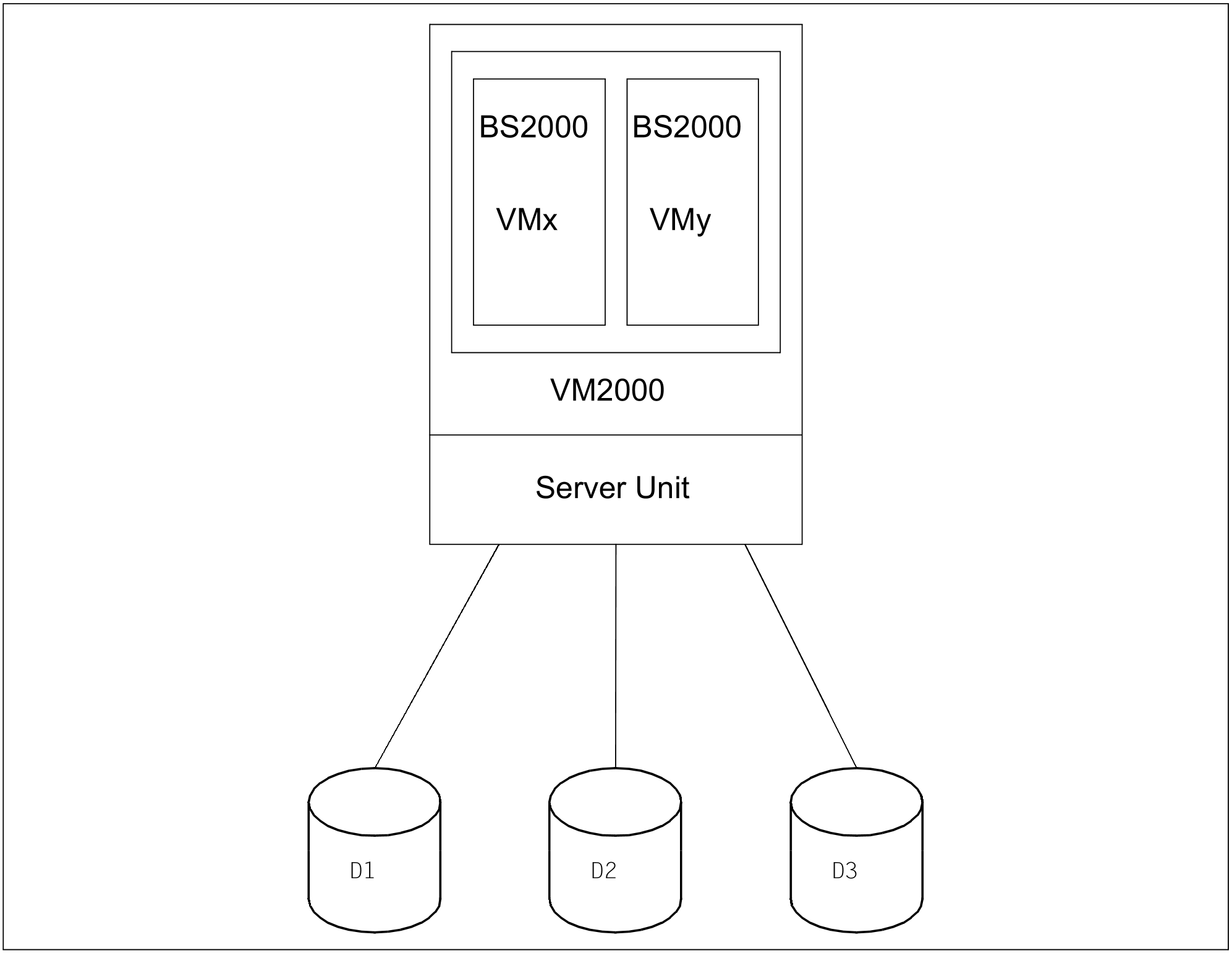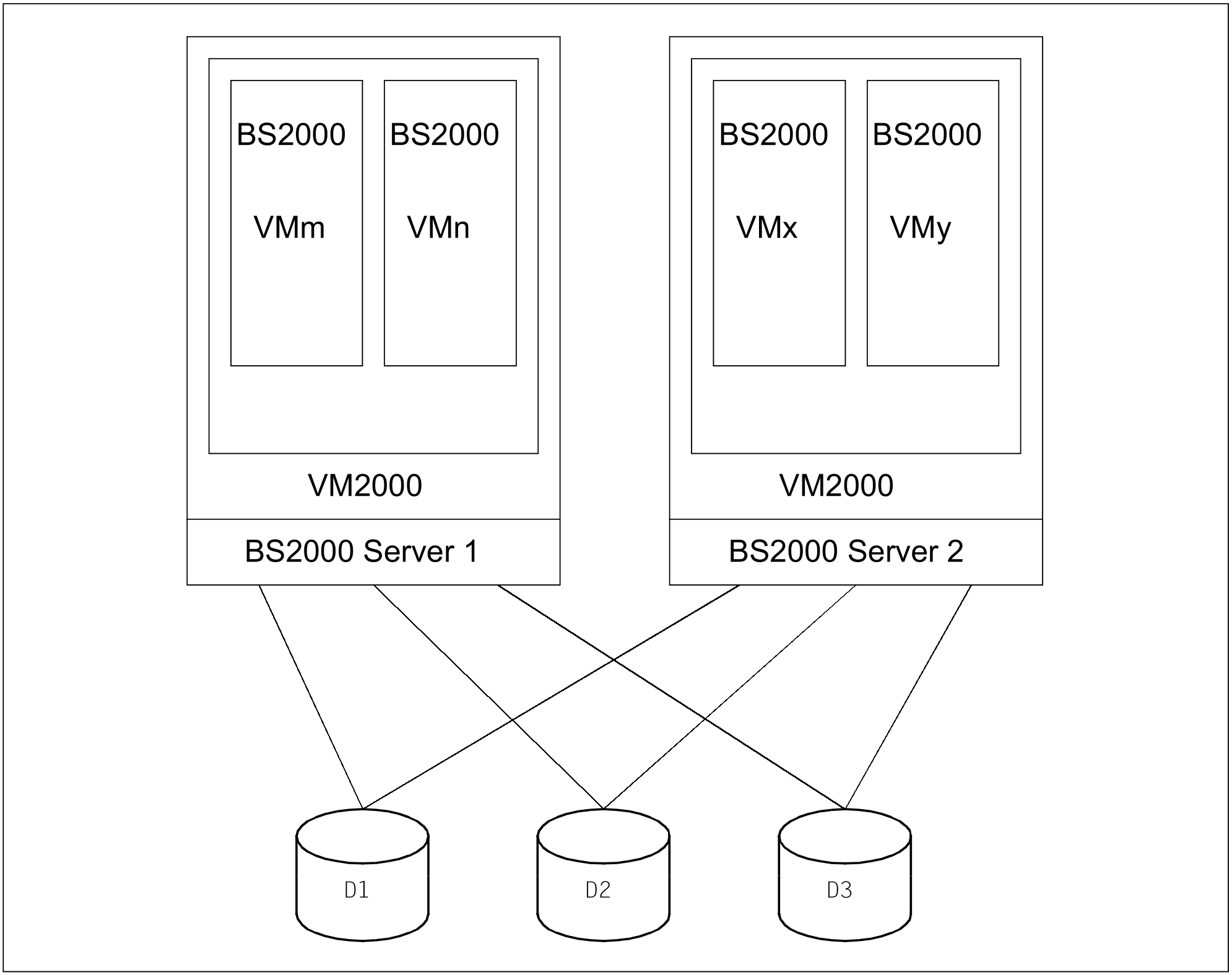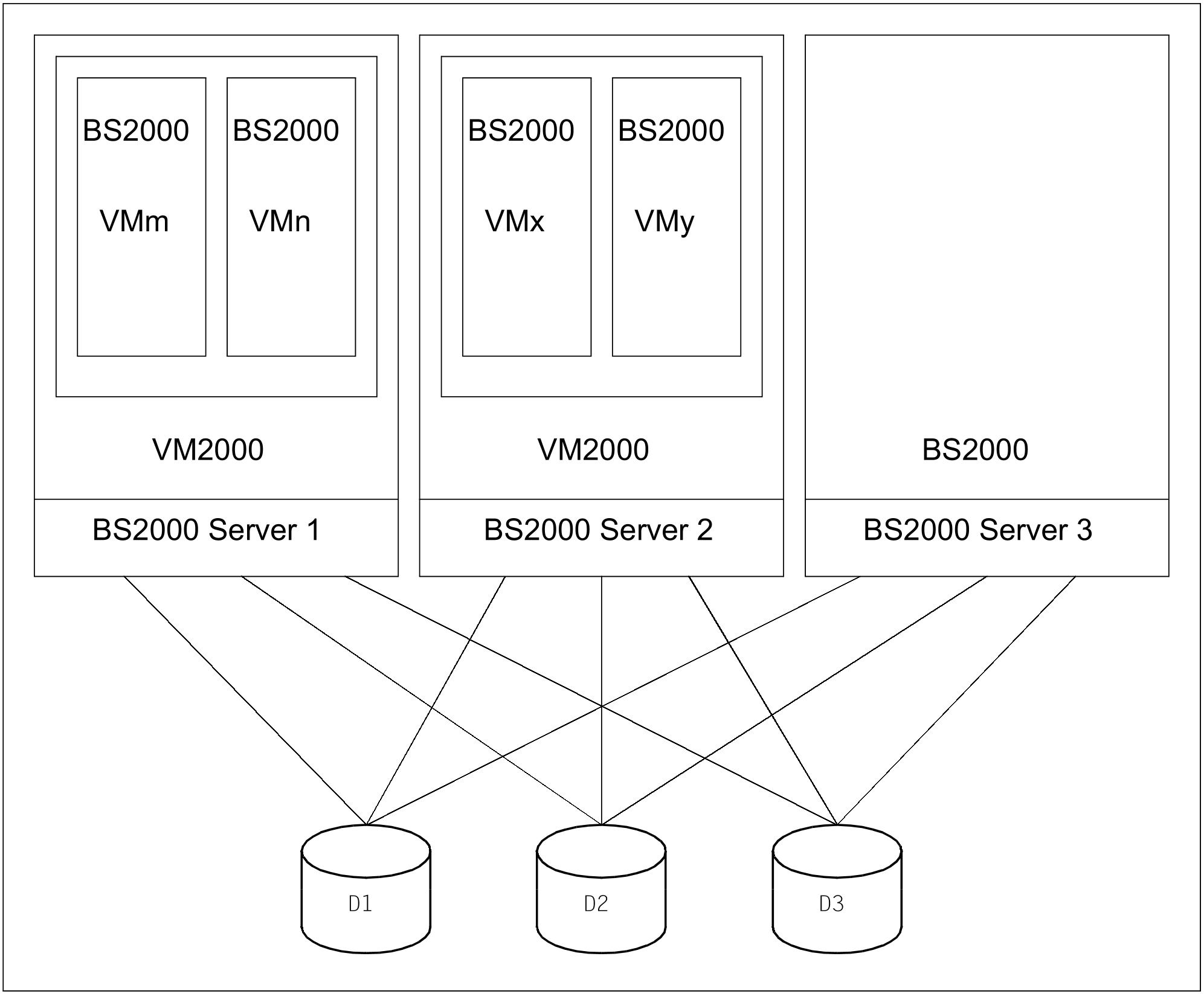VM2000 supports SPVS mode (SPVS=Shared Pubset) of disks.
When the software product HIPLEX MSCF and a corresponding configuration of the BS2000 servers are used, simultaneous access to a shareable pubset is possible via several BS2000 servers (see the “HIPLEX MSCF” manual [10).
Depending on whether the virtual machines wishing to share disks are set up on the same Server Unit or are distributed across several BS2000 servers in a multiprocessor network, the VM2000 administrator must take different measures which are described on the pages below.
In a multiprocessor network, not only Server Units with or without VM2000 operation can execute, but also other BS2000 servers with or without VM2000 operation which wish to work with shareable disks.
The term BS2000 server in this section refers to a BS2000 system irrespective of whether it runs on a Server Unit /390 or x86 (on the same SE server or on different SE servers).
At most 16 BS2000 servers can work simultaneously with a shared pubset.
Input/output handling for shared disks
Sharing of disks by several VMs on one Server Unit
The shared use of a disk device by different VMs on one Server Unit is initiated by implicit or explicit device assignment to the VM in SHARED usage mode, see "Usage mode of a device" (e.g. with /ADD-VM-DEVICES ...,TYPE=*SD). The SHARED usage mode is retained at /SWITCH-VM-DEVICES.
Desired configuration:
VMx and VMy wish to use the disk devices D1, D2 and D3 for SPVS mode.
Action to be taken by the VM2000 administrator:
Disk devices D1 through D3 must be assigned to each VM as shareable, e.g. with the commands:
/ADD-VM-DEVICES UNITS=(D1,D2,D3),VM-ID=VMx,TYPE=*SD
/ADD-VM-DEVICES UNITS=(D1,D2,D3),VM-ID=VMy,TYPE=*SD
Figure 20: Sharing of disks by several VMs on one Server Unit
Sharing of disks in a VM2000 multiprocessor network
In a multiprocessor environment, several BS2000 servers with VM2000 are operated in parallel. Each BS2000 system can access shared peripheral devices. The BS2000 systems run as guest systems under VM2000.
The following configurations may be possible:
Desired configuration:
On BS2000 server 1 only VMm and on BS2000 server 2 only VMy wish to use disk devices
D1,D2andD3for SPVS mode (see Figure 21).Action to be taken by the VM2000 administrator:
Disk devices
D1throughD3should be assigned to VMm and VMy exclusively with the command:/ADD-VM-DEVICES UNITS=(D1,D2,D3),VM-ID=VMm,TYPE=*NONE/ADD-VM-DEVICES UNITS=(D1,D2,D3),VM-ID=VMy,TYPE=*NONEDesired configuration:
On BS2000 server 1 only VMm and on BS2000 server 2 both VMs wish to use disk devices
D1,D2andD3for SPVS mode (see Figure 21).Action to be taken by the VM2000 administrator:
Disk devices
D1throughD3should be assigned to VMm exclusively with the command:/ADD-VM-DEVICES UNITS=(D1,D2,D3),VM-ID=VMm,TYPE=*NONEDisk devices
D1throughD3must be assigned to both VMs (VMx and VMy) as shareable, e.g. with the command:/ADD-VM-DEVICES UNITS=(D1,D2,D3),VM-ID=VMx,TYPE=*SD/ADD-VM-DEVICES UNITS=(D1,D2,D3),VM-ID=VMy,TYPE=*SD
Sharing of disks in a mixed multiprocessor network
This section applies to configurations that meet the following general criteria:
SPVS mode between several BS2000 systems on different servers
At least one of the BS2000 systems active in SPVS mode is running as a guest system under VM2000
At least one of the BS2000 systems active in SPVS mode is running in native mode
Example of a mixed multiprocessor network
The Figure 22 shows an example of a configuration of the Fibre Channel peripherals in which, in addition to a native-mode BS2000 system, two other BS2000 servers (on each of which several BS2000 systems are running as guest systems under VM2000) access shareable disk devices.
Desired configuration:
On BS2000 server 1 only VMm and on BS2000 server 2 both VMs wish to use disk devices D1, D2 and D3 for SPVS mode. On BS2000 server 3 a BS2000 system is operated without VM2000, and, together with the VMs on the other BS2000 servers, it wishes to use the disks for SPVS mode.
Action to be taken by the VM2000 administrator:
Disk devices
D1throughD3should be assigned to VMm on BS2000 server 1 exclusively with the command:/ADD-VM-DEVICES UNITS=(D1,D2,D3),VM-ID=VMm,TYPE=*NONEDisk devices
D1throughD3are to be assigned to both VMs (VMx and VMy on BS2000 server 2) as shareable, e.g. with the commands:/ADD-VM-DEVICES UNITS=(D1,D2,D3),VM-ID=VMx,TYPE=*SD/ADD-VM-DEVICES UNITS=(D1,D2,D3),VM-ID=VMy,TYPE=*SDBS2000 on server 3 acts like a BS2000 in the native network (see also the “HIPLEX MSCF” manual [10]).



